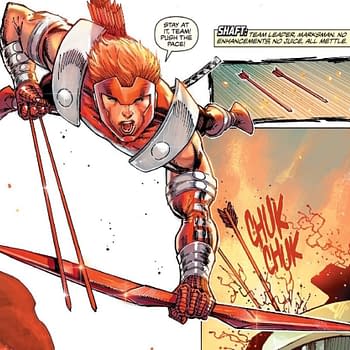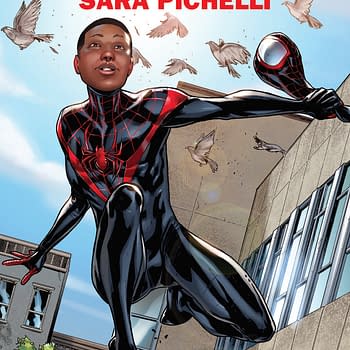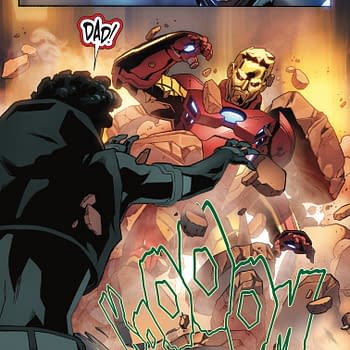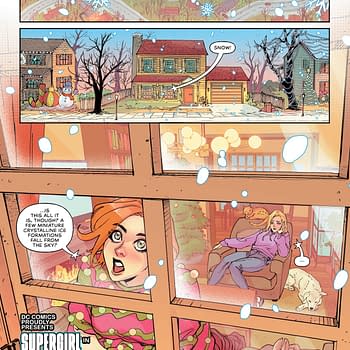Posted in: Comics | Tagged: Comics, comicspro, dark horse, keynote, mike richardson
Mike Richardson's Keynote Address To ComicsPRO

Hello. I want to thank the people at ComicsPRO for inviting me this year. I also want to thank all of you for supporting Dark Horse for 26 years now.
I'm very happy to be here among my fellow comics retailers. I know you were expecting to hear from the president and publisher of Dark Horse Comics, but I've actually been a retailer longer than I've been a publisher and I thought I might get a better reception if I was one of you. It might even surprise you to know that the first issue of our first publication, Dark Horse Presents #1, was pasted up on the counter of my retail store in Beaverton, Oregon. I think that retail experience makes Dark Horse unique in the comics industry. Obviously, we have a better understanding of the problems facing the people who sell our books.
The idea of someday opening a shop that sold comic books first occurred to me in the '70s while I was attending college as an art major. Secretly, I still loved reading the comics that had meant so much to me in my youth, butI was over 18 and after all, comics were for kids.In those days there were no comic shops, soyou bought comic books differently. My own favorite method was to pull up across the street from a 7-Eleven at midnight, where the large windows offered a view of the entire store. I'd wait until no other customers were in the store, dash in to the "Hey Kids" spin rack, and hurriedly search for my favorite titles. Then it was a race to pay the cashier, stuff my books into a brown paper bag, and make my getaway before anyone saw me. It occurred to me that there might be a better way to purchase comic books.
In 1979, I quit a great job, packed up my wife and newborn baby, and moved 150 miles away, and on January 1, 1980, Pegasus Books opened in the little town of Bend, Oregon. It was the best move I ever made, although my friends didn't think so. After all, I was selling comic books. They actually attempted an intervention—that is, the ladies took my wife out and my buddies cornered me, doing their best to persuade me into giving up my crazy idea. After several hours of them trying to talk me into returning to my old job, I finally agreed with them. Obviously I had no intention of following through.
My first store was just 400 square feet. It featured an outside reader board that advertised the latest releases. I filled the local radio waves with ads for comics, held sales, brought in comic creators for signings, and basically ran my business like a business. Those early days were exciting, with each day's sales higher than the last, each week better than the last week, and each year setting new records. My customers were not just the kids, teenagers, and college students I had expected, but doctors and lawyers and, not so surprising, people just like me. All they needed was a place to go, a destination that treated their hobby with respect. A place to congregate and just talk comics. My store was exactly that and my own enthusiasm was infectious. Soon I opened a second store and then a third. Much has changed since those days.
There's an old curse that says, "May you live in interesting times." Well, as everyone in the book business knows, we certainly live in "interesting" times. It seems that the rules are changing around us. New distribution channels, the digital age, and the economy itself are forcing change, change that is not always welcome. Whether publishing, retailing, or distributing printed material, it sometimes feels as though our industry is under an all-out assault. I've been asked to talk about the future of comics, but it might be helpful for us to take a look back at our past to understand that, for the comic industry, change has been a constant and necessary partner.
In 1934, Max Gaines and Harry Wildenberg essentially launched the comic-book industry with Famous Funnies #1, a collection of reprints from popular newspaper strips. It was only a few years later that a failed comic-strip character brought about the first wave of change to the fledgling industry. Action Comics #1, featuring the debut of Superman by Jerry Siegel and Joe Shuster, was an immediate hit, and the age of the superhero was born.
Almost from the beginning, comic books were under assault. In 1940, for instance, the National Education Association Journal ran an article discussing "An Antidote to the Comic Magazine Poison." Not much later, Dr. Fredric Wertham began his infamous crusade against the four-color trade, culminating in the 1954 publication of Seduction of the Innocent. Later that year, Dr. Wertham testified in the Senate Subcommittee on Juvenile Delinquency. To avoid legislation intended to stop, quote, "the deleterious effect" comics had on America's children, the comic-book industry essentially muzzled itself, creating a self-policing entity known as the Comics Code Authority, a move that stifled creativity in the medium for decades to come.
Despite self-imposed censorship, and years of dismal sales, comics bounced back from their '50s doldrums behind DC's reimagining of their '40s characters and the birth of the Marvel Universe. The '60s became a time of experimentation for a whole new generation of creators. Comics flourished for nearly a decade. But the '70s held a new threat. The cover price of a comic in 1938 was 10 cents and it didn't change until 1962, when a 2-cent price increase was enacted. A series of small increases followed over the next decade. By the mid to late '70s, comic books still sold for only 25 to 30 cents. A great bargain for the comics reader, but not so great for the retailer who stood to make three or four times that by selling a magazine in its place. As the locations offering comic books dwindled, so did comic-book sales. Many predicted that the era of the American comic book was over.
Enter Phil Seuling, who went to DC and offered to buy nonreturnable comics in exchange for an additional discount. The deal they struck was directly responsible for the rise of the direct-sales market and comic specialty shops soon sprang up all over the country. While newsstand and ID sales continued to shrink, this young retail network supplied newfound demand for the comic books they sold. The newsstand model was incredibly wasteful, with 75% or more of a title's print run often returned for destruction. The direct-sales model allowed retailers to order what they could sell, and publishers to print what was ordered. The new system spawned startling successes (books such as Teenage Mutant Ninja Turtles might never have seen the light of day under the old newsstand model), and it is certain that publishing companies such as Dark Horse could never have existed without it.
The '90s arrived, bringing along a whole new group of publishers, and with them, a brand-new boom. It was short lived, but once again, the direct market spawned a great success, Image Comics. This fresh publisher was made up of young creators who were able to do what the creators they idolized could not: start a company they owned and finance it through the complete ownership of the work they created. Something else happened during this decade: traditional bookstores were finally taking notice, and graphic novels began to find increased space on their bookshelves.
The first ten years of the 21st century were nothing if not interesting. The decade began with the dot-com bust—dedicated comics distributors, once numbering close to twenty, were whittled down to a single company. And of course, one of the worst recessions in America's history hit in 2008. A tough decade, to be sure, but there was a bright light. Before the year 2000, the least likely comics reader might be a girl in her early teens, but the introduction of shojo—that is, Japanese comics intended for young girls—led to a huge sales spike in American bookstores. The Washington Times reports that between 2002 and 2007, the manga field grew by 350%, from sales of $60 million to sales of $210 million. This gave proof to the notion that there really are untapped markets out there . . . readers who will come, if we are able to get the right product into the right hands.
Now we come to the latest hot button: digital distribution. One study says that we will see nearly 100 million tablets sold in 2012. According to the study, that number will increase to 326 million sold in 2015. By 2016, there will be one billion tablets in the hands of consumers. But that's not all—488 million smartphones shipped in 2011, a 63% increase from the previous year. It's time to realize that the digital revolution is not coming; it's here, and it's been here for a while.
Comics publishers, including Dark Horse, have moved quickly into that space, and those who hesitate may find it hard to make up ground. For a publisher, digital distribution offers solutions to many of the problems of the past: problems including inadequate distribution, high production costs, inventory issues, and outside censorship. As a publisher, I have to admit that the prospect of having 100% of the Dark Horse library available 24 hours a day worldwide is an exciting one. At the same time, it creates the same anxiety for me that it does for some in the retail community. Comic specialty shops are our lifeblood, and the last thing I want to do is harm that market. As I said, without the direct market, there is no Dark Horse. So, what if we are able to think differently and use this digital tool to bring new customers into our market?
I've seen figures that estimate that the total pool of people in the United States that regularly buy comics is no more than 1.5 million, and may be as low as 500,000. Whatever the real number, we know that it has been shrinking for some time. Now let's consider the 1 billion tablets I mentioned a moment ago. Is it realistic to guess that 1% of those tablet owners might download a comic at some point? That's 10 million readers, many times the existing consumer base for comic books. If we can get just 10% of those downloaders to visit a comic store for the first time, we've effectively doubled our market. Yes, I know, we're talking worldwide sales, and it might sound like I'm reaching. How can we find half a million new customers for the direct market? I'd like to suggest that they are out there now, ready and willing, but for a variety of reasons . . . price, distribution, content, e-commerce, and piracy . . . they don't bother. Just the same, they are out there. How do I know that? Well, Jeff Smith's Bone has sold roughly 7 million copies in North America alone, and we're all watching the phenomenal sales continue to climb for Robert Kirkman's The Walking Dead. Clearly consumers exist in numbers far exceeding those who regularly patronize our market. Obviously every publisher would agree that we need to help find those people and bring them into your stores.
So how do we capture them? How do we capitalize on the potential customer base that digital offers, or reach those consumers who appear willing to purchase the right content?
Some ideas:
• Digital outreach. Some of these programs already exist. Dark Horse, for instance, has created exclusive digital content available only through the comic shops. These programs need to be designed to not only bring new readers into your stores, but to give them an incentive to purchase something while they are there. Digital distribution does not have to be an enemy, draining readers away from retail; instead it can be a powerful magnet to find and attract new customers.
• Communication. Some of you might know a meek and quiet retailer in San Francisco. His name is Brian Hibbs. I don't get to speak to Brian as often as I'd like, but when we goof, he often talks with me more than I want. Brian is a great barometer for the things Dark Horse does right, and of course, the things we do wrong. In a fairly recent visit to his store, I asked him about several programs Dark Horse offered where the response was somewhat disappointing. Brian responded that we didn't do a good job getting the message out, and that we needed to improve our communication with the retail community. He was right. You may have noticed that our marketing department has undergone some changes. Change offers a company the opportunity to reevaluate itself, and one of our initiatives for this coming year is to improve our communication with retailers. We want to know your thoughts and we want you to know ours. One way to accomplish this is greater interaction with ComicsPRO. I'll do that one better. I have a boxful of business cards with me. Please ask me for one. If you will send me an e-mail with your thoughts about what you feel Dark Horse can be doing to help you as a retailer, I will promise to consider every request and respond as quickly as possible.
• Tie-ins with major media properties. Comic-based film releases offer a great opportunity to promote retail products, whether through traditional marketing, digital tie-ins, or social networking. We've also seen a huge response to content from game-based properties. Media tie-ins work, bringing in new customers, something we discovered years ago with properties such as Sin City, 300, and Hellboy, a fact currently being demonstrated by The Walking Dead. There are plenty of opportunities on the horizon with comic-based films such as Dark Horse's upcoming R.I.P.D., based on the Peter Lenkov graphic novel, and games such as Mass Effect. But . . .
• We need diversity of product. It's not enough to simply offer the same titles month after month in the same narrow superhero niche. Has anyone noticed sales are falling? If we want to grow the industry, we need to take some chances, with both publishers and retailers supporting new projects that have the potential to appeal to the very customers we seek. We need to offer the same variety of content present in other entertainment forms. Superheroes may pay the bills for now, but they aren't bringing in new customers. In January, only three comics passed the 100,000 mark. That kind of news makes it all the more important for publishers to create new titles that will stand the test of time. Rather than flooding the market with titles that come and go, we publishers need to commit to the titles we believe in, while searching for the next Sin City, Hellboy, The Goon, or Bone.
• Social media: Social networks offer an amazing opportunity for retailers to interact with their customers. Studies show that consumers respond far more positively to the shared opinions of products on Facebook and Twitter than they do to traditional marketing material. Nielsen reports that:
– More than 40% of consumers go online to check reviews and consumer feedback before purchasing consumer electronics.
- 60% of those going online have visited a social network, with half going back every day, according to Facebook.
- 23% of social network users expect companies to listen and respond to what is said online
Clearly these networks offer the opportunity to extend the reach of any retailer. I'm sure you've all heard the story of Comic Book Ink in Tacoma, a financially distressed retailer who used Facebook, Twitter, and reddit to put out an appeal for help. The response to their SOS saved their store and demonstrated just how powerful social media can be. Every retailer should learn how to use these tools to their advantage.
• Price incentives. We've seen the success of Free Comic Book Day. Promotions centered around free or inexpensive products work well to bring in casual customers. For instance, in 2010, Dark Horse released a number of first issues for 1 dollar, as well as offering free content online to arouse interest.
• Community. While our shops may not be able to compete with Amazon on selection or price, we can offer something Amazon cannot, and that is community. As a shop owner, I know that my customers want to talk comics. They want to meet the pros who create them. They want to learn the latest info and hear the most recent rumors. Amazon cannot match our ability to connect with our customers.
There are a variety of other opportunities out there. The big boxes are closing, and those customers have to go somewhere. I've mentioned shojo and its impact on overall graphic sales over the last decade. Borders, where some estimates say one-third of all manga sales were made, no longer exists. The customers who bought those books were unique to our market. Where did they go? We need to find them and bring them into our stores
• Kids and smartphones. There's been an ongoing discussion for years on how to bring kids back into the market. I shared the number of smartphones shipped last year. It seems that every boy and girl in America spends time playing games and downloading apps on their cell phone. We need to find ways to get into that space with content and coupons and bring those kids into our shops.
For eighty years, comics have survived all of the challenges thrown at them, and there have been many. But it's important to understand that today's comics industry owes its existence wholly to the direct-sales market. By that term I mean the comic specialty retailers, and more specifically, the people sitting in this room. Not the publishers, not the distributors, but you, the retailers. After all, it was you who allowed comics to flourish when the traditional bookstores were not interested, it was you who created the conditions in which new companies and talent could take chances and be successful, and it was you who took the industry out from beneath the yoke of the censors. Yes, the direct market, composed of a few thousand dedicated retailers, and created as a solution to a specific problem, has become the engine behind which future problems can be solved.
I can stand up here all day and talk about all the ideas we have and make assorted proposals and promises, but the real reason I'm here is to listen to you. I want to know what you think and where we can help. You are on the front lines. As a publisher, it is in our own best interest to partner with you and to find ways to keep you profitable. We want to help create events and programs using all of the tools available to help you continue to build the community that will keep your store healthy and prosperous.
The bottom line is this: We are living in a time of change, and that change has affected comics fans, retailers, and publishers alike. Things will continue to change, but we will do our best to be there and help in every way we can. Like you, I'm in this business because I love comics. I like to read them, I like to make them, I like to sell them. And there's something else I share with everyone in this room . . . I like to hold them.
Thank you.















